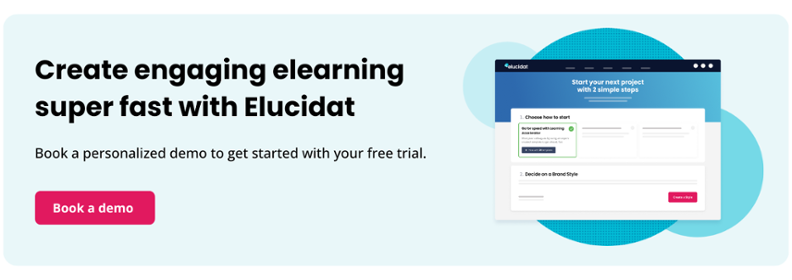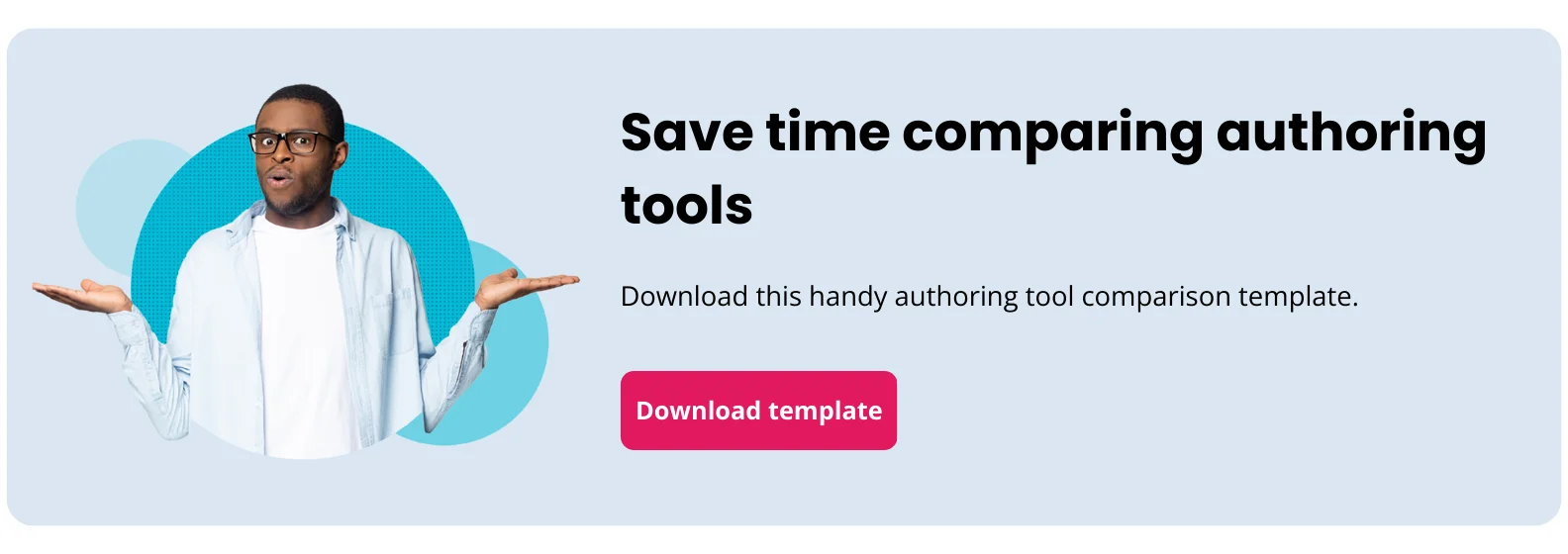5 authoring tool examples to help you make the best choice
9 minute read
Check out our top 5 examples of authoring tools and find the right fit for you. Choosing content authoring tools may not feel like an easy process, particularly with an authoring software available for many different requirements. With so many factors playing their part, you can find yourself juggling between several different software choices. So, how do you find the best elearning authoring tool for you and your team now, and a few years down the line? We’ve put together of authoring tool examples to help you make a choice.

Elearning authoring tool examples – at a glance
Don’t have time to read through each tool example now? No problem – here’s a quick overview:
- Elucidat – cloud-based authoring tool – designed for big employers aiming to drive down the cost of producing business-critical training.
- Articulate Rise – cloud-based authoring tool – part of the Articulate 360 package with the ability to create device-responsive content
- Easygenerator – cloud-based authoring tool – user-friendly, requires no coding, no installation and is fully responsive
- Articulate Storyline – desktop-based authoring tool – solely for Windows PC, PowerPoint style, with high-quality output.
- Adobe Captivate – desktop-based authoring tool – a powerful tool with the ability to create complex interactions, but comes with a steep learning curve.
Content authoring tools come in all shapes and sizes. Some are simple, some complex, some are even included with learning management systems! What it really boils down to when choosing an authoring tool is the type of corporate elearning experience you want to create, what your learners are expecting and the team behind it.
The authoring software you choose now will likely affect your workplace learning content in the long run. With that in mind, there are some key questions you should be asking yourself:
- Do I need SCORM output, xAPI and/or online releases?
- What does the onboarding process look like?
- Will it help my team to work faster and smarter?
- Can I manage multi-course variations and brands?
- Are you looking for a rapid authoring tool?
- Will the content be high-quality and provide an effective learning experience?
And finally…
- Should I use a desktop or cloud-based authoring tool?
This list of 5 elearning authoring tool examples will give you a quick rundown of what to expect different types of authoring tools offer you.
5 different types of authoring tools
To keep it simple, we’ve split these 5 examples of online authoring software into ‘cloud-based’ and ‘desktop-based’ tools.
Let’s take a deeper dive into the features of each authoring tool…
Cloud-based multimedia authoring software examples
Cloud-based software has grown significantly in popularity in the past few years. With the rise of cloud software giants like Dropbox and Google Drive, more and more people are experiencing the freedom and collaboration that cloud-based software brings. A cloud-based elearning authoring tool gives you the same benefits and more! Allowing your team to work together faster and smarter.
1. Elucidat
Elucidat’s cloud-based authoring tool is designed to make it easy for big employers to drive down the cost of producing business-critical training. With Elucidat you get measurable outcomes: smart workflows to scale up content production and reach bigger audiences, a collaborative approach to authoring, and unparalleled support and coaching from a team whose sole focus is client success.
Elucidat is also a rapid authoring tool, with a difference. But what is a rapid authoring tool? A rapid elearning authoring tool is an online training software that helps corporate elearning professionals create effective online training courses, quickly and easily. Course designers can produce anything, from simple digital learning such as quizzes to more complex interactive content, super-fast. The challenge is that this speed can sometimes decrease quality. This is not the case with Elucidat. Our user management and Learning Accelerator add-on ensure that you can involve your subject matter experts (SME) without risking quality. Share access securely, let your SME’s create using ready-made blueprints, and then simply release using our rapid release tool.
| Elucidat Strengths | Elucidat Weaknesses |
|---|---|
| Creating high-quality corporate elearning content with exceptional results | Like any new authoring software, you need to invest some time to utilize the full capabilities of the tool (although, our professional services team are on hand to help!) |
| Speeding up your production by working smarter with streamlined processes | Not ideal for small scale learning projects (i.e. with hundreds of learners) as the platform and pricing are designed to deliver ROI for teams creating and managing elearning authoring at scale (thousands of learners) |
| Recommended ‘templates‘ based on your project goals, helping to build digital learning faster | Not ideal for small scale learning projects (i.e. with hundreds of learners) as the platform and pricing are designed to deliver ROI for teams creating and managing elearning authoring at scale (thousands of learners) |
| Giving you a simple way to control and update your brand styles across multiple courses | |
| Getting access to in-app live support and guided tutorials | |
| Creating multi-language and localized versions of your corporate elearning | |
| Releasing and updating content quickly using the rapid release tool to release projects to your LMS, LRS, Elucidat Discovery Center, or the web simultaneously |
Who is Elucidat ideal for?
Elucidat is ideal for ambitious teams that are working at scale. This includes large learning teams with several content authors that are building several courses a year, looking to create high-quality elearning content that will reach thousands of learners and author with multiple course variations and translations. Authors of a beginner, medium or advanced level of authoring will suit – as a professional services package is included in your bundle to get you up to scratch.

2. Articulate Rise
Articulate Rise is a web-based authoring tool included as part of an Articulate 360 update released around the end of 2016. This is important to note if you’re a Mac user, as Articulate doesn’t have a Mac OS version of their main authoring tool – Storyline. Rise offers a range of prebuilt lesson types, custom learning called “blocks,” interactions, and screencasts to create a range of courses. It’s fully device responsive, and pretty quick and easy to create!
| Rise Strengths | Rise Weaknesses |
|---|---|
| No software download unlike Articulate’s main authoring software | Only accessible through an Articulate 360 license |
| Short learning curve and can start creating quickly | Limited customization and flexibility – content can look very generic |
| Pre-built templates, or use ‘blocks’ to create your own | Lacking in accessibility options |
| Quick to create good-looking (relatively simple) corporate elearning content | Storage limitations in place |
| As it’s cloud-based you can collaborate with colleagues | No learner tracking or analytical feedback |
Who is Rise ideal for?
Rise is a great tool for experienced articulate users to quickly churn out a neat bit of corporate elearning content, ready to go on any device. As a collaborative tool, it’s also useful for Articulate users who want to work together on a piece of content, in real-time.
Read the full software review for Storyline 360, Rise and Elucidat.
3. Easygenerator
Easygenerator is a user-friendly cloud-based authoring tool that requires no coding, no installation and is fully responsive. The clue is in the name… the tool is focused on making elearning authoring as simple as possible for the user – which has its drawbacks!
| Easygenerator Strengths | Easygenerator Weaknesses |
|---|---|
| Simple enough for completely inexperienced authors to create content | Limited feature range – although is also open to hear suggestions and release updates based on client needs |
| Ability to assign tasks to speed up the creation process, share resources and ask for reviews | Pricing can limit the number of authors and courses you are able to build |
| Built-in tracking and tracing | Not fully what-you-see-is-what-you-get (WYSIWYG) |
Who is Easygenerator ideal for?
If your team is relatively inexperienced, looking to create content quickly and easily, but aren’t fussed with quality of output – then Easygenerator is your ideal tool! As one of the most user-friendly authoring tools out there your SMEs can hop on board and start authoring.
Desktop-based authoring tools
Desktop-based elearning authoring tools are restricted to, you guessed it, desktops! Seen as the ‘old school’ way of authoring, desktop tools are powerful and complex but have their limitations. Nearly always requiring a software download, all the files are saved locally onto your PC, rather than being stored centrally in a cloud. Under this remit comes two of the most popular and well-known authoring tools: Articulate Storyline and Adobe Captivate.
4. Articulate Storyline
Articulate Storyline is the main authoring tool that comes with the Articulate 360 suite. The software is based solely on Windows PC and adopts a PowerPoint style interface. Due to its hefty learning curve, Storyline is usually left to the more experienced author, especially if you’re a powerpoint wiz.
| Storyline Strengths | Storyline Weaknesses |
|---|---|
| Good flexibility and control in terms of content output | Not truly mobile responsive |
| A commonly used tool, so designers tend to have experience | Only available on Mac OS through a simulator – sorry mac users! |
| An active online community who share insights and tips | Time-consuming when collaborating or updating |
| Able to author some quite complex digital learning content (if you know what you’re doing!) | New features require a download |
| PowerPoint import (which we don’t always recommend!) | Can be expensive with large teams |
Who is Storyline ideal for?
Storyline would be ideal for an experienced designer who is confident in designing high-quality content from scratch. Ideally, they would be working solo and would have the ability, and desire, to create complex interactions and simulations. Windows users will also have much less of a hard time accessing the application!
5. Adobe Captivate
As another PowerPoint styled platform, Captivate is Storyline’s biggest software rival. But this time, you can access it on both Windows and Mac! As one of the most powerful, and original, tools on the market you can create some pretty impressive elearning content with this tool. Although, it’s complexity comes with a much steeper learning curve and authoring challenges.
| Captivate Strengths | Captivate Weaknesses |
|---|---|
| Ready-to-go slides or Quick Start Projects to speed up the creation | A steep learning curve with limited support |
| Convert existing PowerPoint content to interactive videos | Limitations of a desktop tool – challenging collaboration, review and version control |
| Create Virtual Reality walkthroughs (if you know how!) | Traditional linear style design compared to more modern authoring tools |
| Effective for screencast and application simulation | A painful process to update and maintain existing content – can be time consuming |
| Interactivity in the output can recognize common mobile-device gestures (e.g., pinch and zoom, swipe) |
Who is Captivate ideal for?
Captivate suites the experienced author looking to push the boundaries of elearning authoring, e.g. creating VR, software simulations and heavily interactive content. If you’re not interested in the benefits of cloud-based software (or if you’re a Mac user!) captivate could be the way to go.
Bonus: open source and free elearning authoring tools
Depending on your size and your affinity to customize your tool, you might also be interested in two other categories: open source authoring tools or free to use. If you are a small organization strapped for cash a good option might be the free version of the iSpring. This tool allows you to create basic courses, it’s desktop-based and aimed at novice learning designers who don’t have to worry about updating content regularly
On the open-source list one to check out is Adapt authoring tool. Adapt is ideal for technical authors who are looking to design bespoke HTML5 authoring through back-end design.
Summary
It’s clear there’s a pretty big contrast in the benefits of cloud-based tools against desktop based. The easiest way to find the right software is to sign up for a free trial and see the tool in action – try it for yourself! To see more authoring tool examples, see this review of 9 elearning authoring tools.
Download the authoring tool comparison template
To smooth out your buyer’s journey, we’ve put together the comparison template, it will save you hours comparing these authoring tool examples!

Interested to learn more about Elucidat? Book a demo to get started.



